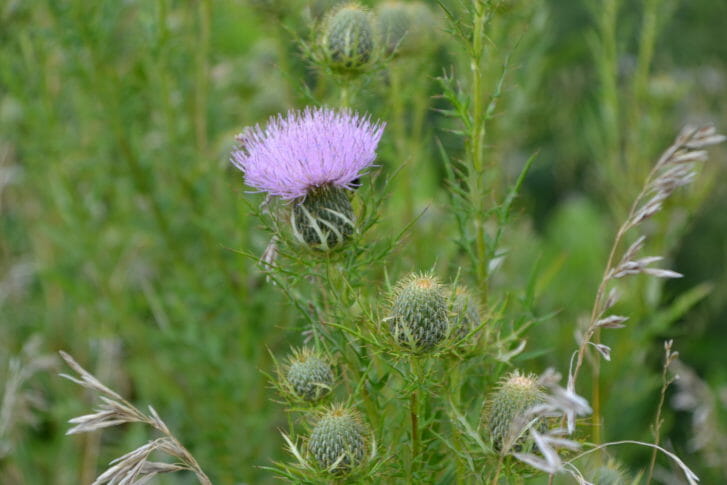Field Day Recap: Beneficial Insect Habitat at Grinnell Heritage Farm
Have you ever seen a farmer so excited to find a thistle? When they’re looking for pollinator-friendly plants, the bigger the field thistle, the better.

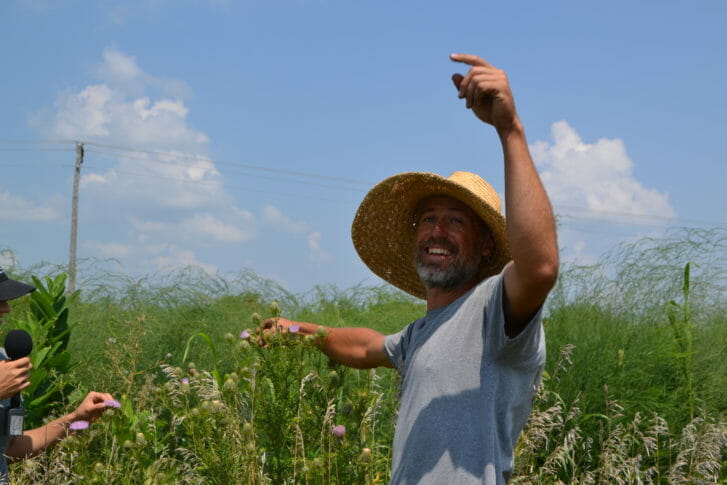
A discussion of native thistles – which continues below – was just one small detail in a field day packed full of information and examples of on-farm habitat for beneficial insects. PFI partnered with The Xerces Society for this field day at Grinnell Heritage Farm, hosted by farmers Andy and Melissa Dunham. Throughout the day, the group discussed the installation and management of beetle banks, flowering shrubs rows, conifer plantings, flowering beds for pollinators, multi-species pasture, and cover crops in vegetable cropping systems. In each system, Andy explained what he did in each particular habitat installation, and Sarah Foltz Jordan complemented his experience with more general information about what beneficial insects were supported by different structures and plant species, and other ways she has seen similar practices implemented on other farms. But, Sarah was excited to be on Andy’s farm, noting: “Many of our (Xerces) recommendations have been informed by what’s going on on this farm. They’re very experimental and trying a lot of neat, new things.”
Native vs. Invasive Thistle
On the field thistle: “This is one of several native thistles to the midwest,” said Sarah Foltz Jordan. “Native thistles have a bad name because many people don’t know we have native thistles, and don’t know how to differentiate the natives from invasive thistles, like Canada thistle and bull thistle. Some bees can only feed their young the pollen from thistle. Some butterfly larvae can only feed on the tissue of the thistle. The best way to differentiate between bull thistle and field thistle is to look at the underside of the leaves; underside of the field thistle (native) leaf is silvery. Sometimes the underside of a Canada thistle leaf has a pale underside, but Canada thistle also has a very small flower. The bracts surrounding the flower of the field thistle are another indicator; bull thistle doesn’t have a bract at all. Other types of native thistles are tall thistle and swamp or marsh thistle (and 60 other species of native thistle). As we’ve been standing here I’ve seen a bumble bee, mining bees, sweat bees, a butterfly and my personal favorite, a small carpenter bee, which is a cavity nesting bee. Hollow stems (like in the photo below the field thistle) are necessary for cavity-nesting bees and other insects.”
[Resource: The Xerces Society Native Thistles: A Conservation Practitioner’s Guide]
Andy admitted that in the past he would have pulled all of those thistles out. Now he leaves them… but, he did remove about 1,000 in the pasture, and left about 500. “They do tend to spread prolifically, and I thought 500 was enough for that pasture,” he said.
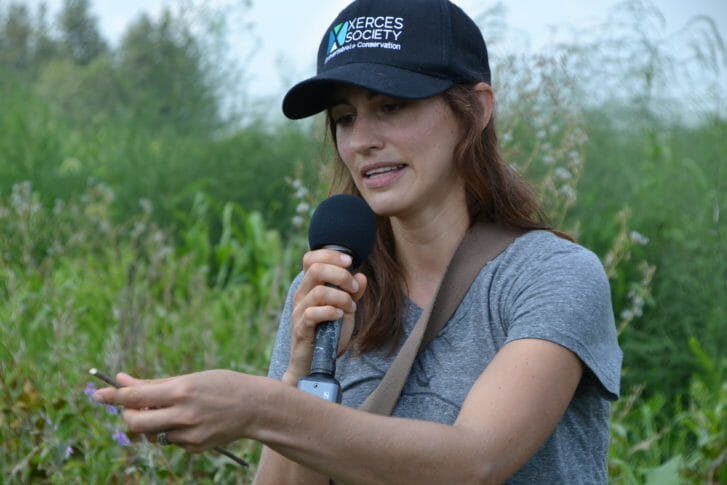
Sarah Foltz Jordan, pollinator conservation specialist with The Xerces Society, shows attendees a hollow stem, about the size used by cavity-nesting sulfur bees.
Beetle Banks
Beetle banks provide critical habitat for predatory ground beetles, which prefer the shelter of bunch grasses like little bluestem. Said Andy: “This weedy-looking patch down the middle of our field is our first beetle bank, installed in 2012. I impaired the success of this beetle bank – I got the bright idea that if I ran my electric fence down the middle of it I wouldn’t have to mow around the fence-posts. But then I attracted all of the birds that live on or near the farm to sit and poop on it, and we ended up with a lot of bird-defecated weed-seeds germinating in the beetle bank, which set it back. Our other beetle bank that didn’t get the fence down the middle has fewer weeds.”
To install the beetle bank, Andy’s neighbor and PFI lifetime member Dewey Murken started all the plants in a greenhouse, then he and Andy used the vegetable transplanter to plant them into a raised bed they made with their bed-shaper. “If you don’t have a bed shaper, you could use a couple of discs or a moldboard plow. Dewey hand-weeded it once that year, and for continued maintenance, we float-mow it once or twice in the spring.”
Said Sarah, “If you are able to grow out plugs in a greenhouse, that’s a great way to start your beetle bank. But if you can’t grow your own plugs and prefer the low-cost method of direct-seeeding, you’ll need to do more site preparation – about a year of weed management ahead of seeding.” Andy added that for some species of plants, buying plugs from a professional nursery is absolutely worth the cost. “Don’t be dissuaded by the cost per tray – you’re paying for very high quality plants that can be difficult to germinate. I’ve had 100% success with plants from Prairie Moon Nursery.” [Xerces Society Resources: Organic Site Preparation; and Establishing Pollinator Meadow from Seed)
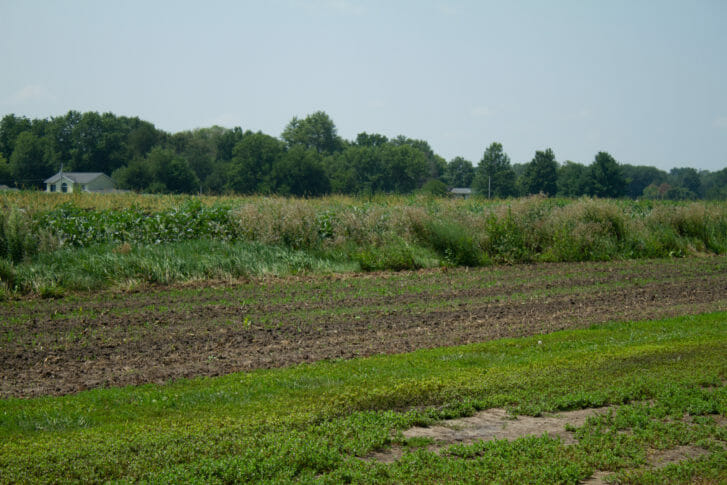
Beetle Banks for Beetles, and for Bees
Predatory ground-nesting beetles have very specific habitat requirements, and will only over-winter at the base of native bunch grasses. Said Andy: “Many of them are not very mobile, laterally, in the field – they might only go 50 or 100 or 500 feet into the field. If you don’t have habitat within your field, you won’t have the benefit of these predatory insects on your farm. At best you’ll only have them on the periphery.”
Sarah added: “On farms were there is a lot of tillage for weed control, these beetle banks are also essential habitat for ground-nesting bees, which make up about 70% of our native bees. The nests look similar to an ant nest, but you won’t see any ants going in and out, and there won’t be a raised mound. Many of these bees have short activity periods, so they might only be flying for a few weeks in the spring or summer; most of their life cycle is under the ground.”
Andy’s next beetle bank, which he plants to install in 2019, will go in where there is currently a 7-species cover crop mix. The beetle bank will have a mowable field road on either side of it. “When we do get weeds germinating in the beetle bank, they tend to creep into our production fields and crowd the vegetables. As long as the mowed strip (field road) is narrow enough, I think the beetles will happily cross it to reach the fields. For this installation, we’re going to transplant into biodegradable plastic, so we won’t have to do any weed management in the first year of the beetle bank. Using this method, we’re planning to install 1,500 feet of beetle banks around our farm.”
When asked if the beetles needed to already be present for the beetle bank to be successful, Andy replied, “If you build it, they will come. We built our first beetle banks in 2012, by 2015 we were really seeing a difference, and seeing many beetles. We see them everywhere – we catch them in our mousetraps. For example, when we dig potatoes now, we usually see one small, black beetle for every potato, and those beetles eat scads of the Colorado potato beetle. I’ve only had to spray for Colorado potato beetle once in the last six years. The only organic-approved product that is effective against Colorado potato beetle is Entrust, which costs $300-600 per acre to apply. I don’t know if these beetle banks increase yield, but they certainly lower our input costs.”

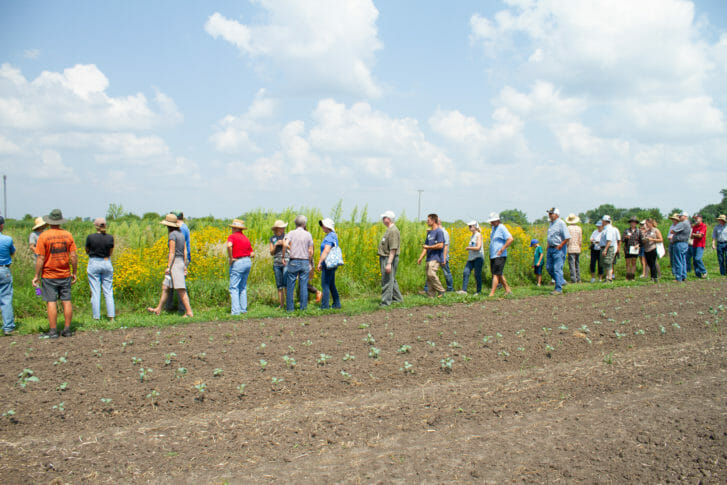
Weed Management in Organic Asparagus; Native Shrubs
The asparagus at Grinnell Heritage Farm has been managed organically since 2007, and still yielding well. The Dunhams seed soybeans after they harvest the asparagus for weed control. Andy used to plant the soybeans into the asparagus with a broadcast spreader, but now uses a 15-ft no-till drill. After the last harvest, he flail mows the asparagus bed, then does a light tillage pass and plants the soybeans.
As he walked along a pollinator bed among his vegetable beds, Andy identified shrubby St. John’s wort, pasture rose (not multi-flora rose), rose hips, prairie clover, mountain mint, prairie onion, blazing star, hyssop, blue false indigo, butterfly milkweed and various asters. Sarah noted the excellent bloom succession in the pollinator planting, which is particularly important for bumble bees.
Beyond the asparagus, next to the road there is a 1,000 ft-long row of shrubs, which includes ninebark, nanny berry, redosier dogwood, and gray dogwood. “If I had to do it over again, I would not put flowering shrubs for pollinators adjacent to a conventional corn field, I would put conifers there, like I did on the other side of the farm, to better project the beneficial insects from insecticide drift. From my farm, I witness drift coming off neighboring conventional corn and bean fields every single year, and none of those drift incidents have ever been reported, to my knowledge, except the two that we reported when we got hit.”
Directly in front of the group in the photo below is a beetle bank, then the fronds of flowering asparagus, and the row of shrubs along the road peeks out at the top.

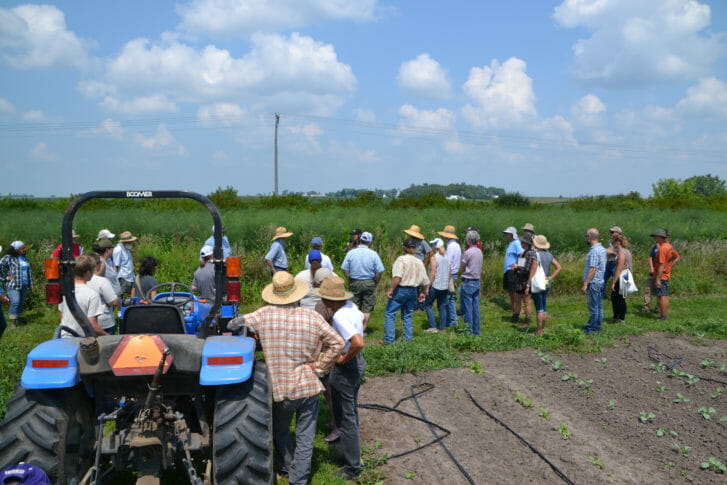
“The first shrub row I planted, I alternated tree species with each plant. For this newer shrub row, I followed the advice of the Xerces Society, doing cluster planting so the pollinators can find them more effectively.” In the photos below, Andy planted the shrubs in clusters of 15-20 plants, then switched to a different species, which include redosier dogwood, silky dogwood, gray dogwood, ninebark and wild plum.
Below, shrubs along the row are planted in clusters, by species.

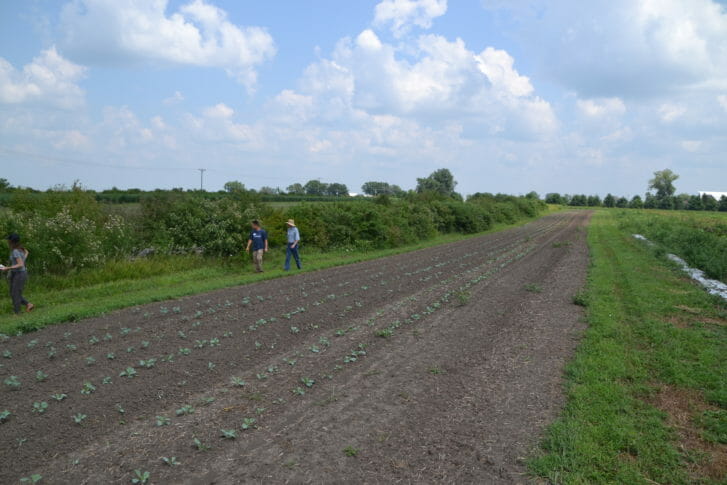

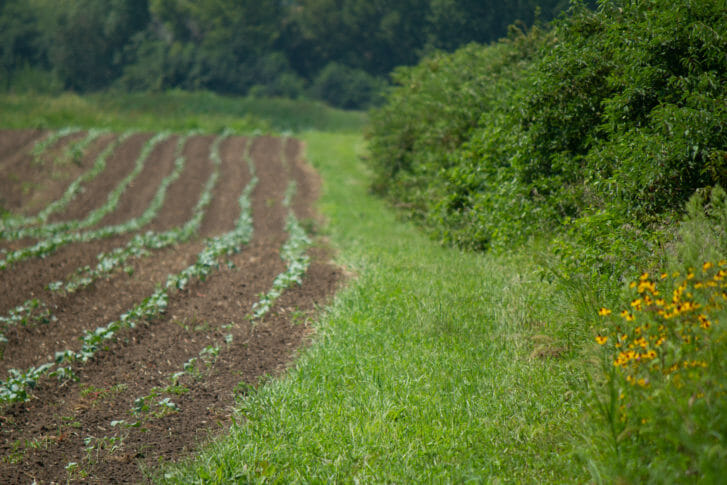
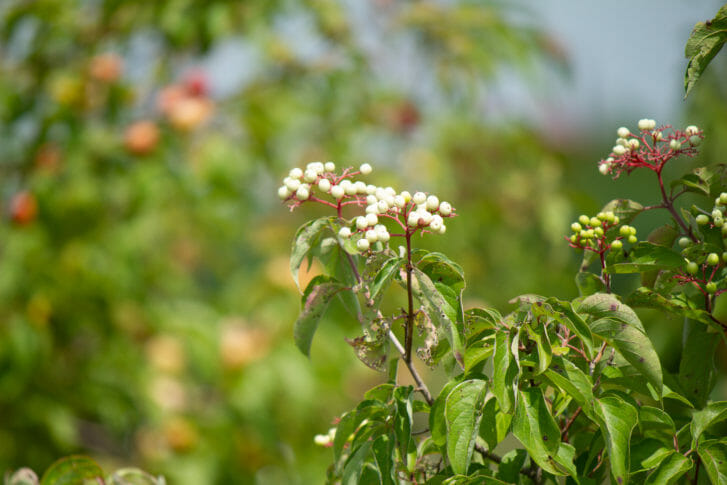
Gray dogwood, with its characteristic red stem.
Wild plums were in season during the field day, providing a quick snack (below). Andy noted that because of the wild plums, the farm is now also home to wild turkeys. “Many of our native shrubs also provide edible fruit,” added Sarah. These include: wild plum, aronia, black raspberry, juneberry, pin cherry, black cherry, choke cherry (a bunch of cherries), blueberry, currants, gooseberry, raspberry, service berry, blackberry, dew berry, and many others.
In addition to the two shrub rows the group saw on the tour, Grinnell Heritage Farm has surrounded their property with more shrubs and hardwood trees, including: hazelnut, aronia, burr oak, red oak, Kentucky coffee tree, black cherry, shagbark hickory. A lot of wildflowers have now moved into those areas.
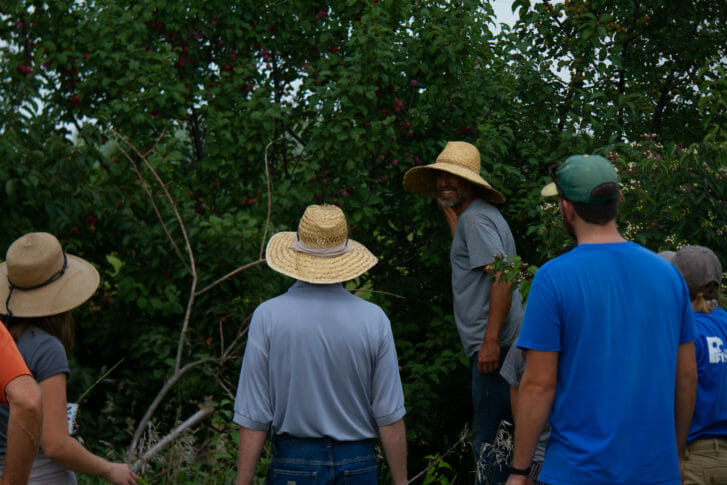

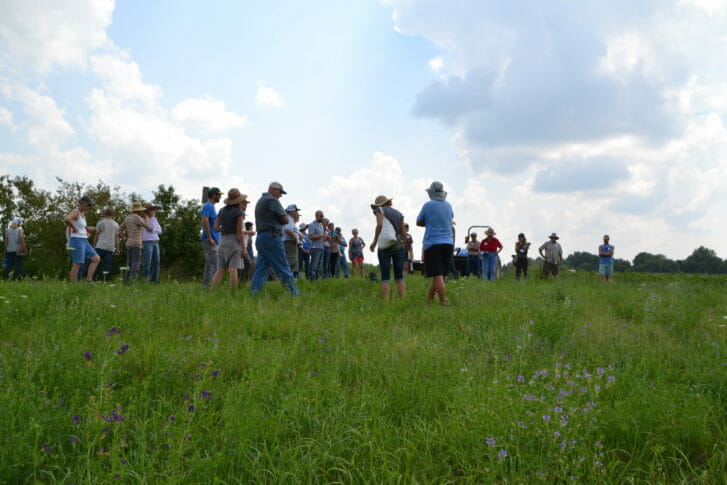
“This hay field was planted in the spring of 2007, as part of our entire farm’s organic transition. With approval from NRCS, this fall we are going to graze it to the ground, then no-till drill new species in to improve our yield on hay,” said Andy.
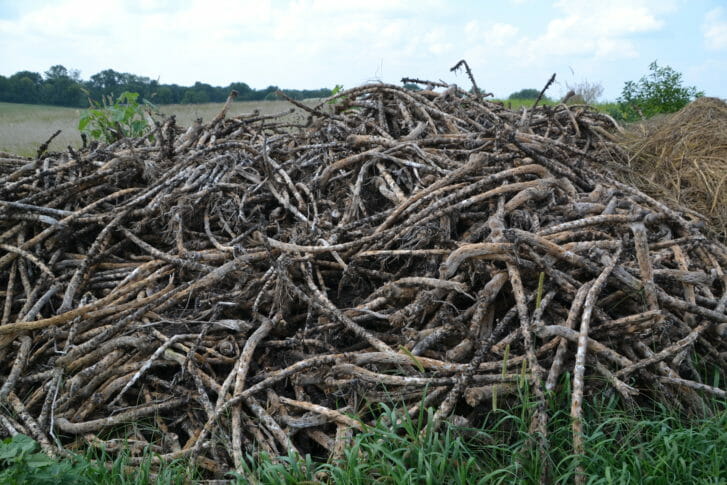
A “bone yard” of Brussels sprout stalks provides excellent habitat for insects.
“I’m finding that my interest in farming, when we have more intentional habitat for beneficial insects, goes up. Looking around, we have some weeds; it’s been a challenging year, in that regard. But if it was just a scorched-earth method of farming… I don’t have any interest in doing that,” said Andy.

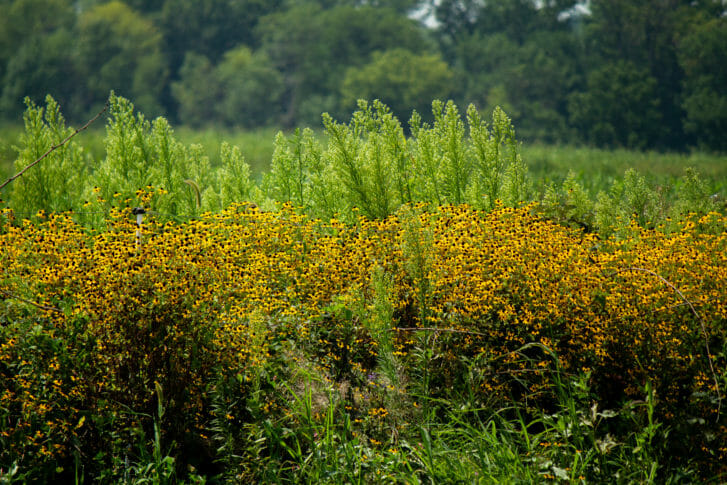
Cover Crops
Andy: “We try to cover crop about 80 percent of our production land every calendar year. If you’re worried about the effects of climate change, and I am, soil organic matter is about the closest thing you get to a magic bullet. It helps when it’s flooding, it helps during a drought, and it helps during perfect conditions. You can hold about 20,000 more gallons of water per acre, for every 1 percent you raise your soil carbon. Not to mention it helps sequester carbon.”
Andy suggested that a good rotation to add to a conventional corn and bean farm’s rotation would be to harvest a cereal rye for seed, bale the straw, then drill sorghum sudangrass and either graze, greenchop, or make hay out of it. It would fit with the corn and soybean production schedule. Additionally, sorghum sudangrass is a good nitrogen scavenger, and requires about half the water that corn does.
Andy lets the sorghum sudangrass grow as long as weeds in it aren’t going to seed (if so, he float-mows waist high). He lets the sorghum sudangrass stand through the winter, which provides pheasant habitat. By spring the sorghum sudangrass has winter-killed, providing a thick mat over the field. He’ll add composted cow manure in the spring, and then plant an early June brassica crop. Andy typically follows carrots with Sorghum sudangrass, as the smothering cover crop also supresses root-knot nematodes, which are hosted in the aster family (which includes carrots).
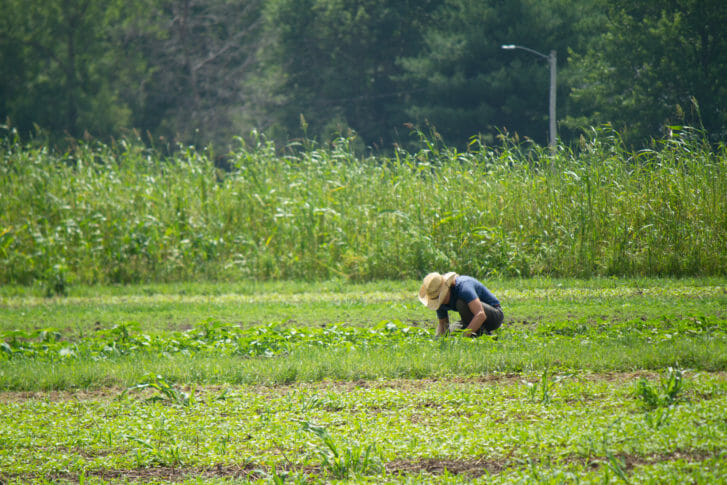
Sorghum sundangrass behind a worker weeding in a carrot field.
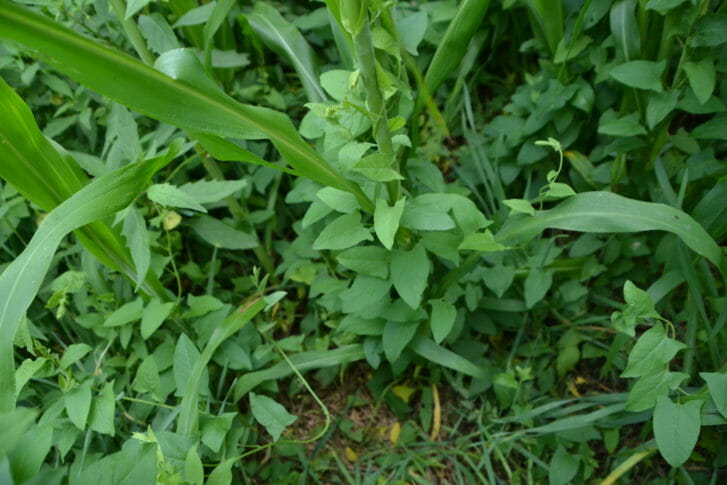
2018 was a particularly bad year for morning glory (field bindweed), which is thick on the stalks of this sorghum sudangrass.
How It Looks Early On
In the mowed strip below, Grinnell Heritage Farm and The Xerces Society collaborated to plant over 20 different species of flowering shrubs and some conifers in the fall of 2017 – which are all such small bare-root trees, they aren’t really visible unless you look closely for them. 2018 was a very dry year on Grinnell Heritage Farm, and without irrigation on this strip, Andy is expecting some loss on conifers. The strip is also mulched with wood chips. This 5-foot wide strip will provide even more spring blooms to the farm, and is in place better protected from insecticide drift than the other flower shrub row. Andy noted that shrub rows on the periphery are easier to manage, but having the shrub row in the middle of the farm really elevates the presence of beneficial insects and birds. “Grandpa would be rolling over in his grave if he saw us planting shrubs in the middle of the cornfield,” he said.

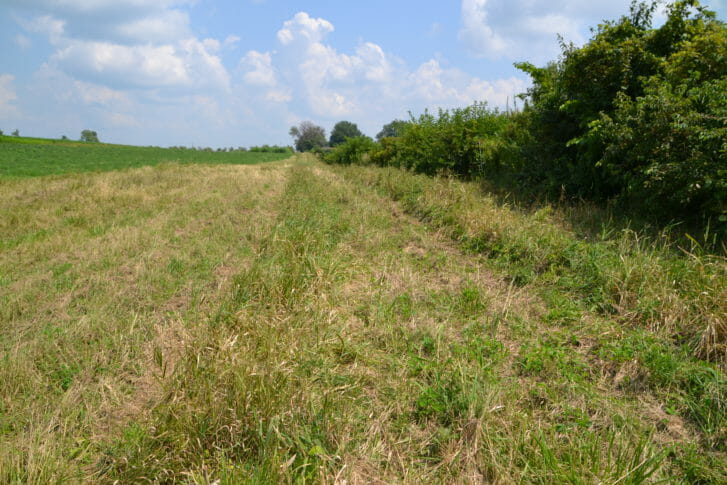
Grinnell Heritage Farm invests in these conservation practices to meet their long-term goals, which include making the farm enjoyable for visitors who come for pizza night and other events, supporting wildlife, and increasing the productivity of the farm. “How much we spend depends on the year we’ve had, and luckily we can do a lot of this cheaply using skills and equipment we already have,” said Andy.
Grinnell Heritage Farm also has a number of pollinator gardens around the farm, which have many native forbs and grasses. Some of these are direct seeded, others are transplanted from the greenhouse or from Prairie Moon Nursery, or planted as cuttings of other plants, as possible. During the pizza night later that evening, dozens of kids took insect nets to these gardens and all the surrounding areas, adding an ecological element to their night on the farm.

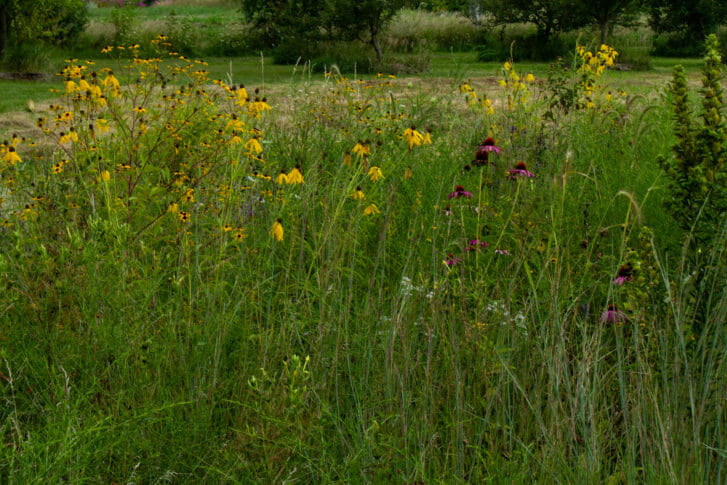
Following the tour of Grinnell Heritage Farm (and before the Pizza Night at the farm began), the group carpooled to Grinnell College’s Conard Environmental Research Area, for a brief tour led by CERA manager Elizabeth Hill. The 365-acre prairie and oak savannah is used for class field trips, student and faculty research, and quiet enjoyment by the public for birding, hiking, painting and drawing, and photography. Below, Elizabeth Hill discusses student and faculty research about prairie management (holding a leaf of prairie dock).

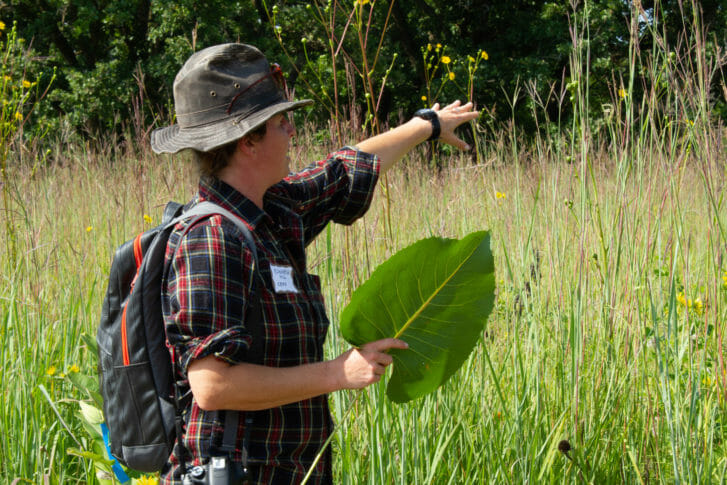
Support for this field and recent habitat projects at this farm were provided by an Iowa NRCS Conservation Innovation Grant. Additional sponsorship for this field day was provided by MOSA Certified Organic, Iowa Environmental Council, and Iowa Farmers Union.
To hear directly from Andy, check out PFI’s promotional video for Grinnell Heritage Farm’s field day.

